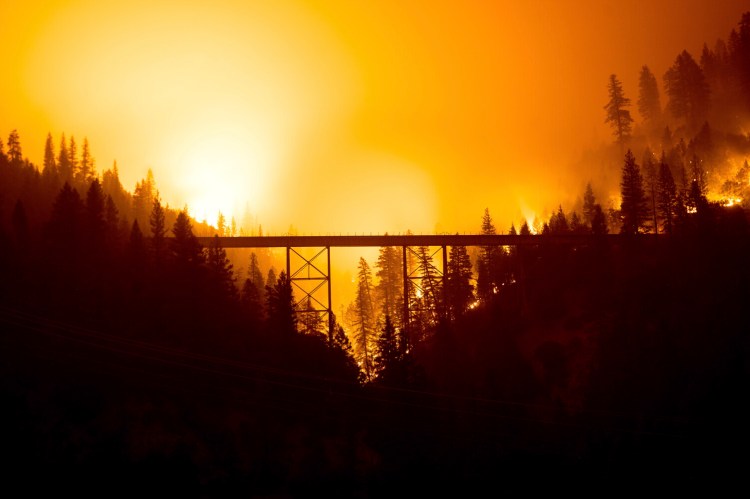A fire scorching parts of Northern California’s Butte County – the same county that in 2018 endured the deadliest wildfire in state history – has ballooned into the state’s largest wildfire so far this year.
The Dixie Fire, which ignited July 13, has burned through more than 190,000 acres in swaths of Butte and Plumas counties as of Sunday morning. Officials expected more extreme fire behavior ahead.
More than 5,000 people are battling the blaze, which has destroyed 16 structures, including some residences, and is threatening more than 10,000 others as it rages in the two counties.
“The threats and risks associated to this fire are very real,” Mike Minton, an incident commander working on firefighting efforts, said during a briefing on Saturday. “We’re observing fire behavior, conditions and fuel conditions that are not common for this area. So the rapid rates of fire growth that we’re seeing are very real.”
The fire, which officials said remained active overnight, was 21 percent contained as of Sunday morning. Fire officials said late Saturday that the Dixie Fire and the smaller Fly Fire had “come together tonight.” The Fly Fire was most recently reported to be spread across 4,300 acres.
Democratic Gov. Gavin Newsom declared a state of emergency on Friday in four northern counties because of multiple fires, including the Dixie and Fly fires.
More than 7,500 people were under evacuation orders in Plumas and Butte counties as of Friday, according to the California Governor’s Office of Emergency Services.
Exceptionally dry conditions and high temperatures this year have fueled the growth of wildfires in Western states. Eighty-eight large fires are actively burning in the United States, including nine in California.

William Deal wets down his 1977 Trans Am as the Dixie Fire approaches Crescent Mills in Plumas County, Calif., on Saturday. Deal, who lives in a community under evacuation orders, told the Associated Press he plans to stay to defend his home from the fire. Noah Berger/Associated Press
The Bootleg Fire in southern Oregon is the largest of the blazes burning in the nation. Some progress has been made in recent days in halting that fire, which had burned more than 408,000 acres as of Sunday and is 46 percent contained.
During a Saturday briefing on the Dixie Fire, officials repeatedly urged residents to heed evacuation orders.
The evacuation orders for the Dixie Fire include communities along the western shore of Lake Almanor, a resort area in Northern California about a two-hour drive north of Paradise – the town in Butte County that was ravaged by the Camp Fire in 2018. That fire, which killed at least 85 people and was the state’s deadliest and most destructive on record, sent people fleeing, with some of them settling in Lake Almanor.
Plumas County Sheriff Todd Johns spoke directly to residents of one community in Taylorsville, Calif., on Saturday, some of whom he said had not yet evacuated.
“You know how steep the mountains are behind you. If you have not done so, I highly encourage you to evacuate if you live on Arlington Road in Taylorsville,” he said. “The fire activity at this point … it’s extreme. Sometimes it’s unpredictable or most of the time it’s unpredictable, and I just asked the folks that live in Taylorsville that are wanting to stay there to reconsider that.”
An investigation into the cause of the Dixie Fire is ongoing. In a preliminary report last week, Pacific Gas and Electric, California’s largest utility, noted that some of its equipment may have played a role in sparking the fire.
In the report filed to the California Public Utilities Commission, PG&E said a utility employee observed on the morning of July 13 a possible blown fuse uphill from where he was located. Because of “challenging terrain and road work,” the worker could not reach the fuse until nearly 10 hours later, when he observed multiple fuses blown as well as a fire near the base of a tree.
PG&E equipment has been linked to numerous California blazes in recent years, including the Camp Fire.
Copy the Story LinkSend questions/comments to the editors.



Success. Please wait for the page to reload. If the page does not reload within 5 seconds, please refresh the page.
Enter your email and password to access comments.
Hi, to comment on stories you must . This profile is in addition to your subscription and website login.
Already have a commenting profile? .
Invalid username/password.
Please check your email to confirm and complete your registration.
Only subscribers are eligible to post comments. Please subscribe or login first for digital access. Here’s why.
Use the form below to reset your password. When you've submitted your account email, we will send an email with a reset code.